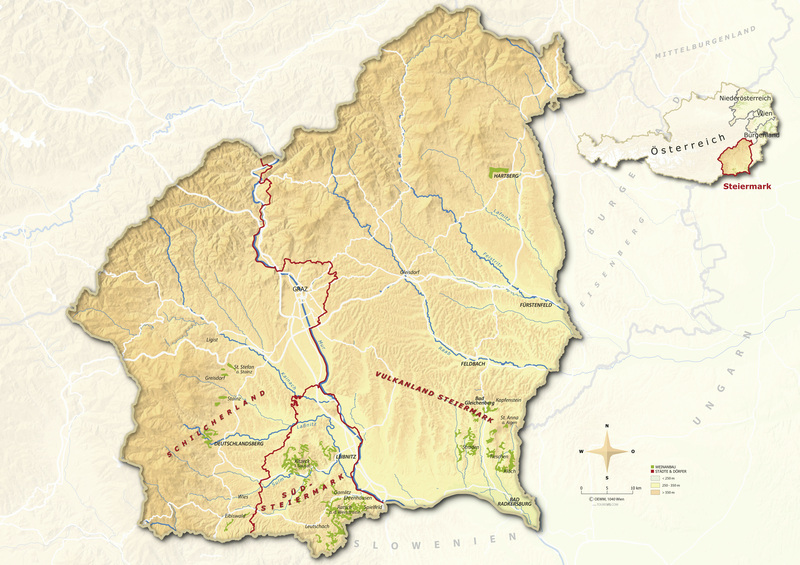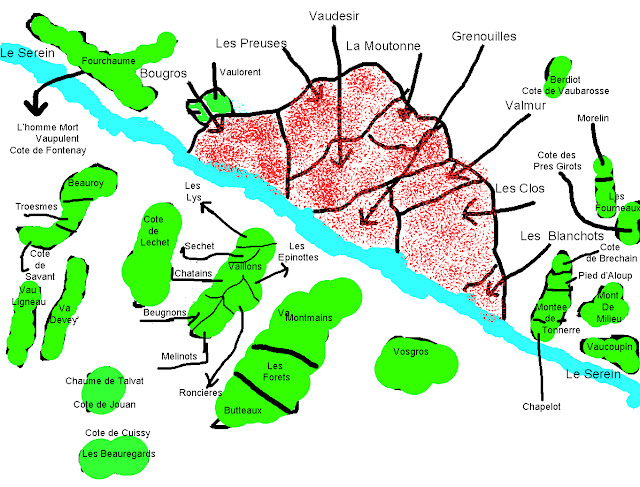Steiermark Styria “Green Heart” of Austria.
Steiermark Styria a region with 4633 hectares under vines.
The terrain here is hilly, mountainous, and many of the vineyards are planted on steep slopes to take advantage of sunlight and the winds. The climate is definite continental, winters are still quite cold, and annual rainfall is high however is warmer than most of Austria's wine-producing regions, and is almost Mediterranean in nature. The growing season is long, and grapes have time to develop flavor complexity while retaining their acidity.
The wines of Steiermark are particularly distinctive. Volcanic soils in Sudoststeiermark provide an excellent foundation for the aromatic Traminer varieties, while the high altitude and limestone soils in Sudsteiermark produce wines made from Sauvignon Blanc. The fresh, racy Schilcher rosé from Weststeiermark enjoys cult status; the grape varieties for the Schilcher is called Blauer Wildbacher is an extremely late-ripening, dark-skinned wine.
The most widely planted variety is the Welschriesling, with its green apple bouquet, and refreshing acidity.
In the Sausal region and along the idyllic Southern Styria Wine Trail, the aromatic varieties Sauvignon Blanc and Gelber Muskateller (Muscat Blanc a Petit Grains) are predominantly.
The new system of level is Gebietsweine, Ortswein, and Riedenwein.
Each new vintage in the Steiermark is celebrated with a light-bodied young wine called the 'Junker', which debuts during the first week of November. In March and May of the year following the harvest, the dry wines are released.
The wines I tasted from this region later
Strohmeier
Franz Strohmeier, working in the Steiermark part of Styria, Franz holds 8-hectares of vines all managed with natural methods. No Cooper Sulphate has been used instead the grapes are sprayed with whey (the liquid part of milk produced in cheese production). There are no recognize body certification for organic or biodynamic practice however Franz Strohmeier seems to hit all the box of natural winemaking practice. If the disease affects his vines he often prefers not to treat them and let the biodiversity through the vines to create a natural immune system to healing on his own.
2013 TLZ Indigo N'1
Blauer Wildbacher
The wines got a nice rich Ruby red color with a slight garnet rim, medium viscosity, and medium tearing. The nose has a moderate-intense with a hint of developing with jammy ripe black fruit as cherry and plum, notes of compost and dark mushroom with hints of leather. Nice mineral as charcoal and chalky. The Palate is fresh with medium plus acidity, medium body, and alcohol with ripe black cherry, mushroom, and forest floor with dusty tannin like graphite. Lean texture with good complexity, and length.
NV Rose Sekt Blauer Wildbacher
Methode Champenois: some hours of maceration in the first fermentation, Sur latte (on lees) 14 months. Red fruits and very lifted with floral notes, good vinosity with a touch of lees. Palate is tonic and vivid.
Werlitsch
Werlitsch is a small family estate, started in 2004 when took over the farm of their father. They work deeper and deeper in harmony with Nature and people on 8 hectares under vines. The wines are made mainly as white Cuvee grown on our different types of soil. They are so-called Ex-Vero which means "out of the truth" and stay for pure delicate fine wines.
They are a member of the group
"Schmecke das Leben" ("taste life") http://www.schmecke-das-leben.at/
and have the "Demeter" certification.
A mix of 50% Sauvignon Blanc and 50% Chardonnay has been kept 4 years in the neutral wooden cask after pressing on the lees. The vines used to produce it stand on a sparse soil full of limestone with fossil shellfish, at 350-420 meters above sea level.
The color is deep golden. The nose is very ripe and intense with notes of golden apple, Williams pear, and intense minerals notes as flint, wet stone, and salty element.
You find lots of intense, exotic fruits and spices on the palate, too, but little tannins from the skins keep it in perfect balance. Minerality and salty tones make the wine very interesting and exciting. A very intellectual wine.
Andreas Tscheppe
Weingut Andreas Tscheppe is a winery located in Gamlitz (Glanz/Leutschach), a small village in Southern Styria, between Graz and Maribor. Andreas runs a small family boutique winery producing only white wines. Andreas Tscheppe started his winery in 2006. His vineyards are in a very special location, surrounded by rather steep hills and with the vineyards in terraces. He follows the biodynamic philosophy and the complexity of the soils is the basis for expressive wines. Their wines spend 18–24 months on average in oak barrels. Harvest is carefully done by hand.
Andreas elaborates the following wines:
Blue Dragonfly – Sauvignon Blanc
Green Dragonfly – Sauvignon Blanc
Salamander – Chardonnay
Butterfly – Yellow Muskateller
Butterfly – Goldmuskateller
The Goldmuskateller is also an Orange Wine.
This is a wine with power energy lots of tension and mineral notes. Exotic fruit, fresh cut grass rich leesy elements without being tired with crispy electric acidity. Long finish, vertical and horizontal in the palate a kaleidoscopic wine.
Schnabels
The Schnabels have always been associated with the earth through winemaking and holding cattle.
A real farmer.
2014 Hochegg Blaufrankisch
Blaufrankisch in a single location called Hockegg.
This wine is peppery with dark fruit with a nice core of minerality and awesome drinkability.
Only 12% of alcohol with tension acid structure and savory palate along with fresh clean red fruit.
Lean palate with crunchy fruits and stony minerality.
Muster
Maria and Sepp Muster took over his parent's 10-hectare winery in Styria in 2000 and began to work the vines biodynamically. Herbicides and pesticides had never been used. Rocky clay and silt soils dominate the steep hills where the vines are located. This type of soil is called “Opok” which name two of their wines.
2016 Opok cuvee Welschriesling, Sauvignon Blanc, Gelber Muskateller, Morillon (Chardonnay)
All the grapes are destemmed and fermented all together in 1200 liter wooden cask for 10 months, then racking in burgundy barrels where rest for 19months bottles without filtration and fining.
The wine is salty mineral, creamy and complex. Lemon curd with citrus zest infused in gin, High acidity with tension and electric energy.
The Graf wines also feature the Opok soil but have steeper south facing slopes that reduce yields and produce wines of more structure and pronounced mineral character.
Erde is an orange wine can be found in special clay bottles link below:
raffaele mastrovincenzo
Blog
--------------------------------------
wine / spirit / lambic / drinker














Comments
Post a Comment